During the Year of Coasts and Waters 2020, we’re joining SNH staff working along our shorelines and waterways to gain an insight into the important and varied work they do. This month we join Jane Dodd, a marine operations officer based in Oban, on fieldwork to study the critically endangered common or flapper skate, which took place at the start of the month before coronavirus restrictions.
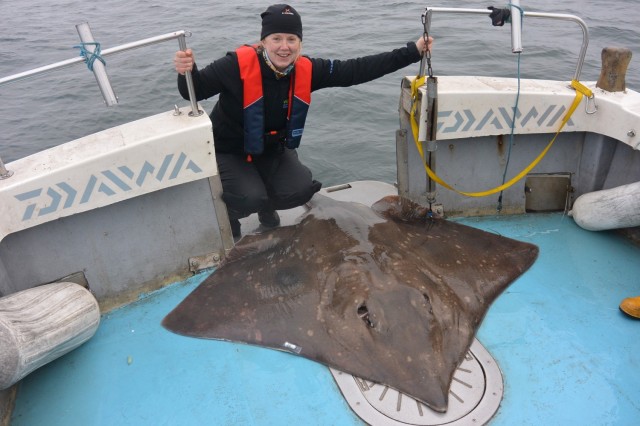
Jane at work ©James Thorburn
Skate spend a lot of their time in water deeper than 100m, so while angling might seem a strange way to study a species, if it’s done well it can help us to learn a lot about them. Today we’re collecting data to help us try to determine when and where the skate lay eggs. Ultrasound images of the ovaries help us to see whether the skate are in breeding condition and blood samples will be analysed for reproductive and stress related hormones.
We are also fitting long-term acoustic tags to provide more detail on the movement of the skate in between captures. Acoustic receivers are stationed throughout the Loch Sunart to the Sound of Jura Marine Protected Area (MPA) and they record when the tagged skate come with ~500m. The tags will track the movements of the skate for around 10 years.
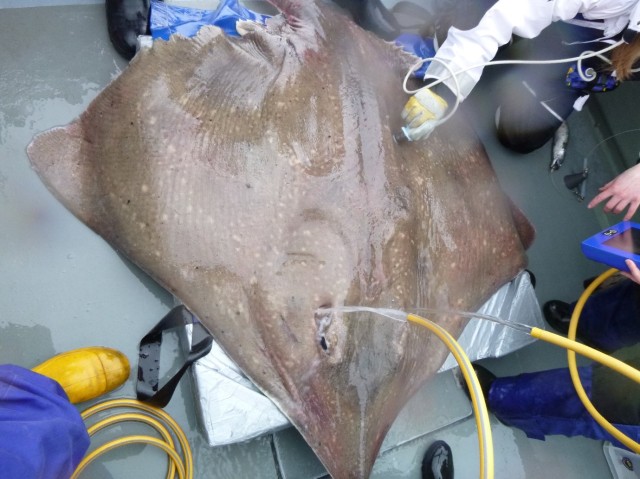
Imaging the ovaries of a skate using ultrasound ©Jane Dodd
The team arrives at Dunstaffnage Marina early and we load MV Bluefin with our equipment for the day. The 40 minute steam from the marina to the fishing mark is nice and calm and our skipper, Roger, drops the anchor, baits up the barbless hooks with large mackerel and drops the lines down while we get our equipment ready.
And then we wait, and wait, and wait until…at 11:30 a rod whirs and we have a skate! I put on a harness and start to reel in the fish. Forty-five minutes and a fair amount of effort later a large female skate appears at the surface and she is landed through the back gate of the boat.
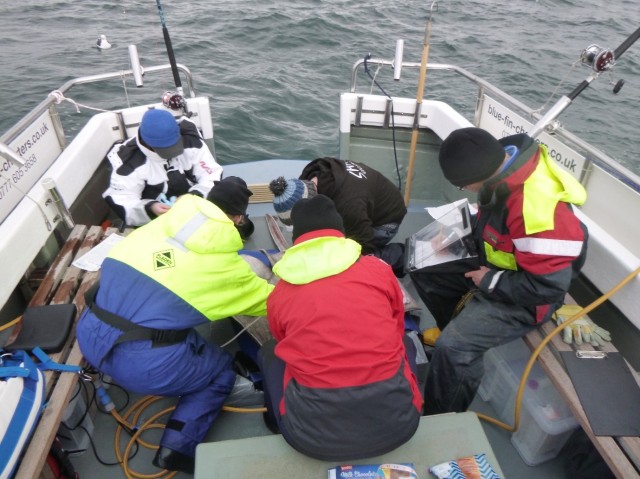
A skate is fitted with a long-term acoustic tag ©Roger Eaton
I scan her with our PIT tag scanner while Ed Lavender, a PhD student at the University of St Andrews, checks the number against the list of previously acoustic tagged fish and we find a match – we have tagged this fish before! Another team member Georgina Cole, a vet at the Royal Zoological Society of Scotland, gives the skate a thorough check and ultrasound while James Thorburn, also of the University of St Andrews, collects blood samples. After we take a photograph of the skate for Skatespotter– an online resource for tracking skate movements – she is lifted into the water and swims away from the boat.
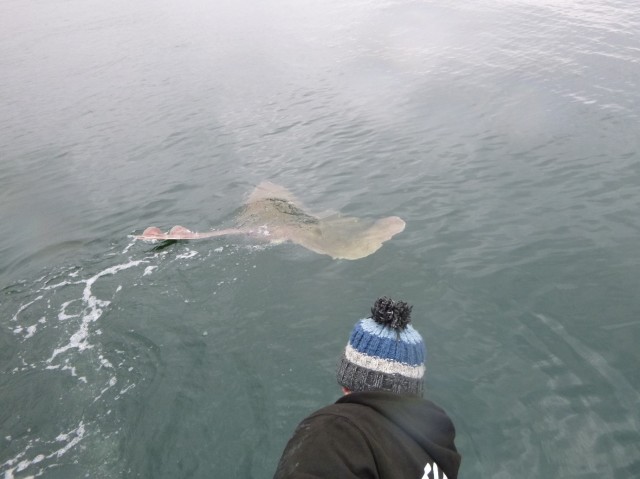
A skate swimming away on release ©Jane Dodd
While Roger baits up the lines again, I check Skatespotter. The tag number corresponds to a 92kg (202lb) female we have seen eight times since 2014. The photos and the tag records, submitted to us voluntarily by skippers running skate angling trips and private anglers, tell us that the skate are making repeated use of the area.
We don’t have to wait long before we get another bite. This time it’s a smaller female (50kg, 110lb). I check the tag number against our list and she has not been acoustically tagged but is known to us, she has been caught 16 times since 2014! We turn the skate onto her back on the specially designed mattress and, as with the first skate, Fenella Wood from the University of Aberdeen, turns on the oxygen cylinder and the water pump so we can deliver oxygenated seawater to the skate’s gills.
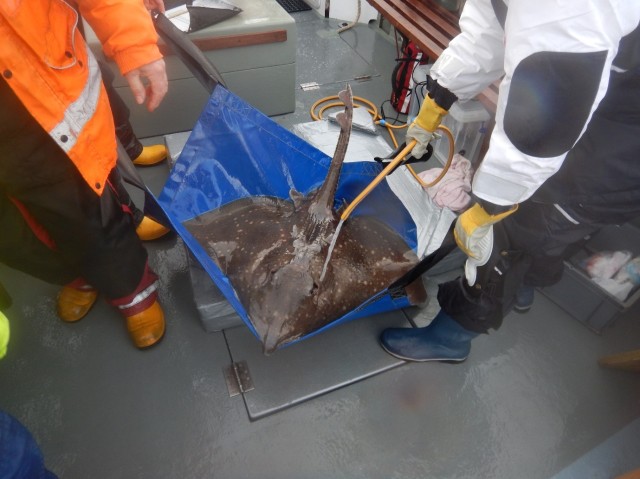
The skate is lifted using a sling and water is poured through the gills until it is released ©Jane Dodd
We check her respirations and heart every few minutes and monitor the time the skate has been on the deck while Georgina fits the tag and James takes blood samples. James also ultrasounds the ovaries and saves the images for analysis later. Five of us work on the skate and we still need Roger to pass us the odd thing because there isn’t much room to move around her on the deck! After 20 minutes we turn the skate back over and lift her through the door at the back of the boat using a sling. She slides gracefully into the water, flaps her wings and swims down.
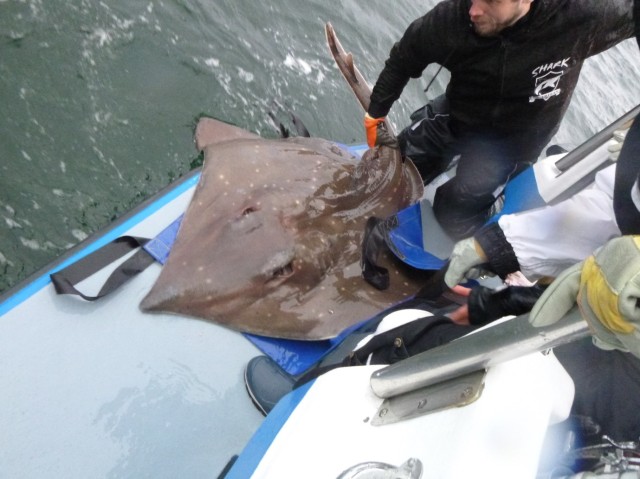
A skate is released back to the sea ©Jane Dodd
We stash everything away against the blustery showers and wait again. The skate live in such deep water we really are at their mercy, if they don’t bite we don’t see any! I am learning to be more patient but sometimes sitting at anchor in a rolling sea isn’t the most pleasant experience, although foot warmers and motion sickness tablets do help! Today we manage to catch and study two more skate before it’s time to pack up, lift the anchor and return to Dunstaffnage. It’s been a successful day – the tag data will allow us to check the status of flapper skate within the MPA, while the ultrasound and blood samples will help us learn more about the ecology of this little-understood species.
Angling on a “catch and release” basis has provided a huge amount of background data about skate, and helped to justify the designation of the MPA for the protection of the species. We are very grateful for the continued contribution of anglers to the monitoring of skate in the MPA. Our Skate Handling Best Practice Guide available on the Skatespotter website has been developed with the help of experienced skate skippers to prevent damage to skate during angling.

You must be logged in to post a comment.